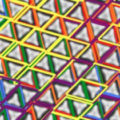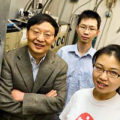
A quantum parlor trick where smaller molecules are “caged” inside the nano-meter sized cavity of a spherical bucky ball (C60 Buckminsterfullerene) molecule could point the way to advanced molecular electronics, say scientists from The University of Nottingham. As well as The University of Nottingham, the work also involved scientists from the US, Japan, France, Estonia and the universities of Nottingham and Southampton in the UK. Their paper, appearing in the journal Proceedings of the National Academy of Sciences, details the caging of H2 and H2O molecules and the possible application of the research in creating a molecular transistor.
The tiny cage, explains researcher Tony Horsewill, effectively creates a nanolaboratory, allowing the detailed study of the quantum mechanical principles that determine the motion of the caged molecule, including the wave-like behavior that is a fundamental property of all matter.
C60 Buckminsterfullerene was discovered in the mid-1980s and earned Professors Harry Kroto, Robert Curl and the late Richard Smalley the Nobel Prize in Chemistry in 1996. It has a cage-like spherical structure made up for 20 hexagons and 12 pentagons and resembles a soccer ball, earning it the nickname “bucky ball.”
In a recent breakthrough in synthetic chemistry, the Japanese scientists from Kyoto invented a molecular surgery technique allowing them to permanently seal small molecules such as H2 and H2O inside C60. They used a set of procedures to open the C60 molecule producing an opening large enough to push a H2 or H2O molecule inside at high temperature and pressure. The system was then cooled down to stabilize the trapped molecule inside and the cage was repaired.
Then, the Nottingham research group employed a technique called inelastic neutron scattering to investigate the “cage rattling” motion of the imprisoned molecules within the C60. Their investigations have provided insights into the wavelike nature of H20 and H2 molecules and their orbital and rotational motion as they move within the C60. “By confining small molecules such as water in fullerene cages we provide the controlled environment of a laboratory but on the scale of about one nano-meter,” explained Malcolm Levitt, at The University of Southampton.
“As with any blue-skies research initiative there is always the promise of new, often unforeseen, applications. Indeed, in the case of water molecules inside bucky balls we have a guest molecule that possesses an electric dipole moment and the collaboration is already investigating its use in molecular electronics, including as an innovative component of a molecular transistor,” added Horsewill.
Related:
Discuss this article in our forum
Vacuum tube tech could save Moore’s Law
Nanotronics within reach with creation of molecule-sized diode
First inexact computer chip aimed at developing world
Getting A Handle On Spintronics

















Comments are closed.